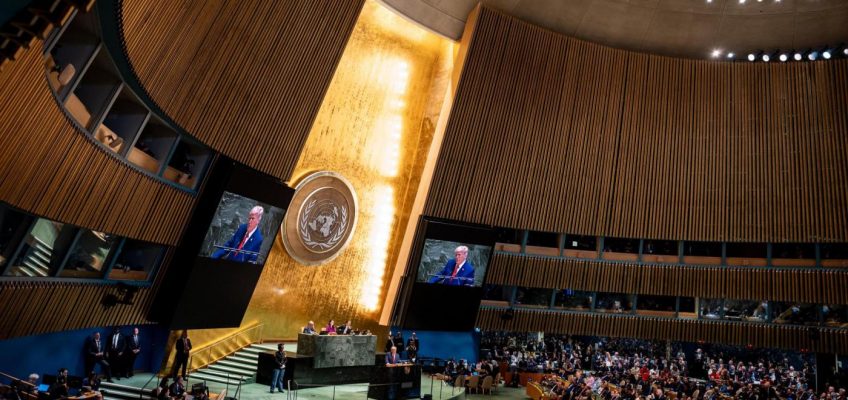The City Council approved the lease of city land to build housing for the formerly incarcerated in the Bronx, over the objections of the local councilmember and City Hall. It’s the first time the Council has overruled one of their own on a land use issue since 2021.
Council Speaker Adrienne Adams ahead of Thursday’s vote not he Just Home plan. )William Alatriste/NYC Council Media Unit)
The City Council approved an application from NYC Health + Hospitals (H+H) to lease land on the campus of Jacobi Hospital in the Bronx, where a nonprofit planned to build 58 units of supportive housing for severely-ill, otherwise-homeless people leaving Rikers Island jails.
Lawmakers voted through the measure Thursday over the objections of the local Councilmember Kristy Marmorato, who opposes the project—a stance that helped her win her seat in 2023.
It’s a rare example of the Council overruling one of their own on a land use and housing development issue, as lawmakers usually defer to the rep whose district a proposal falls in, a practice known as “member deference.”
After years of planning, the Adams administration pulled its support at the 11th hour, writing to the Committee on Landmarks last week that it was “actively reviewing” the project, which in its current form no longer has the support of City Hall.
On Wednesday night, the eve of the Council meeting, First Deputy Mayor Randy Mastro sent a letter to Council Speaker Adrienne Adams urging her not to bring the project to a vote.
“In light of the Mayor’s withdrawal of the application as currently constituted, there would be no purpose to such an authorizing resolution vote and the application should be deemed withdrawn,” wrote Mastro, who added that the city was searching for alternative sites.
He wrote that they expected the support of the Fortune Society, the nonprofit organization that would build and operate the project.
Stanley Richards, Fortune’s CEO, said that they had not been contacted by the administration about any other locations and were not told about the letter.
“If they have identified another site, it’s not that it should be one or the other. We need both sites, because we see that many people walk through our doors who are struggling with housing insecurity,” said Richards.
Council sources disputed that the mayor has the power to withdraw the application. H+H authorized the disposition of the land in a January 2024 board vote, and Council sources said that it would need to be withdrawn or changed by an action of the H+H board, which may need to restart its process for public engagement.
“Randy Mastro’s letter is indeed irrelevant,” said City Council Speaker Adrienne Adams at a Thursday afternoon press conference. If the administration were to continue to fight the project after the vote, “what the mayor can or cannot do at that point remains to be seen,” she said.
H+H has been silent on whether it wants to advance the Morris Park project or consider a revised plan. The agency did not respond to City Limits’ request for comment on this story before publication.
City Hall criticized the Council for waiting nearly two years to address the application, saying lawmakers are “insisting on going forward with a meaningless vote to approve a limited project on a single site that will never happen because the Mayor no longer supports it,” a spokesperson said in a statement to City Limits
Mastro’s letter said the administration would search for alternative sites for supportive and affordable housing in the Bronx, but those projects would not be designed to support formerly incarcerated people, as Just Home would. Community leaders and H+H have previously said that the need for housing for justice-involved people is high.
City Hall did not provide alternative sites for Just Home in response to City Limits’ questions last week. But in a dig at Councilmember Sandy Nurse, a vocal supporter of the project, Mastro included two proposed sites around Brooklyn’s Broadway Junction in the footnotes of the letter.
Both sites would be in Nurse’s district.
“It was definitely a jab,” Nurse told City Limits. “It’s no secret that I’m not a fan of Randy Mastro and I am certainly not a fan of Mayor Adams.”
She added that she recently opened a supportive housing site in her district with Housing Plus, an organization that serves justice-involved people.
The proposed site for the “Just Home” project at 1900 Seminole Ave. on the Jacobi Medical Center campus. (Adi Talwar/City Limits)
A spokesperson for City Hall said that they were seeking an alternative location for the project with more community support and targeted Nurse’s district specifically for the proposed alternatives because of her support for Just Home.
“It is the right type of facility. It is the right location, and that district is in need of doing its fair share of housing. I think it will be very hypocritical if H+H pulled out of this project, or if their board made a decision to pull this,” said Nurse.
Marmorato’s East Bronx district ranked 38 out of the 51 Council districts for affordable housing production over the last decade, according to a tracker maintained by the New York Housing Conference. Nurse’s district ranked 10th, with 4,080 new affordable apartments built between 2014 and 2024, compared to 484 in Marmorato’s.
City Hall’s continued opposition, however, makes it unclear how the Just Home project can proceed.
It may depend on how much H+H considers itself independent from its boss, Mayor Eric Adams. H+H could dispense the land with or without City Hall’s approval, but Fortune Society likely needs the agency’s support to move the project forward, Richards said.
Marmarato urged her colleagues to vote no on the proposal.
“If you claim to care about member deference, then you must across the board,” she said at Thursday afternoon’s hearing. “You cannot say one thing publicly and then act differently when personal feelings are at stake. That’s not democracy. It’s hypocrisy.”
But the Council ultimately approved the land disposition 36 to 9. It was the first time the lawmakers overrode “member deference” since 2021, when they approved the NYC Blood Center’s expansion on Manhattan’s East Side over the local rep’s objections.
In November, voters will weigh in on ballot measures from Mayor Adams’ Charter Commission that seek to weaken member deference. Housing advocates and City Hall argue that the practice results in less new housing during a dire shortage.
Council leadership has downplayed the role of member deference, arguing it helps them secure crucial concessions from developers to serve their neighborhoods. Now they’ve ignored a local member’s objections for the first time during Speaker Adams’ tenure.
Richards is hopeful that the long-delayed Just Home project can now move forward.
He and other criminal justice advocates say access to a stable home is a key public safety measure, and helps ensure those leaving jail don’t re-offend.
A 2022 analysis by the Corporation for Supportive Housing estimated that some 2,500 people held at Rikers Island in a given year are homeless and have behavioral health needs that would qualify them for supportive housing.
“We see that many people walk through our doors who are struggling with housing insecurity,” Richards said. “Because what we know is that when people have housing and people have access to services, it increases the likelihood of them not returning back to the system.”
To reach the reporter behind this story, contact Patrick@citylimits.org. To reach the editor, contact Jeanmarie@citylimits.org
Want to republish this story? Find City Limits’ reprint policy here.
The post Council Approves Just Home Project, But City Hall’s Objections Leave Future Unclear appeared first on City Limits.




